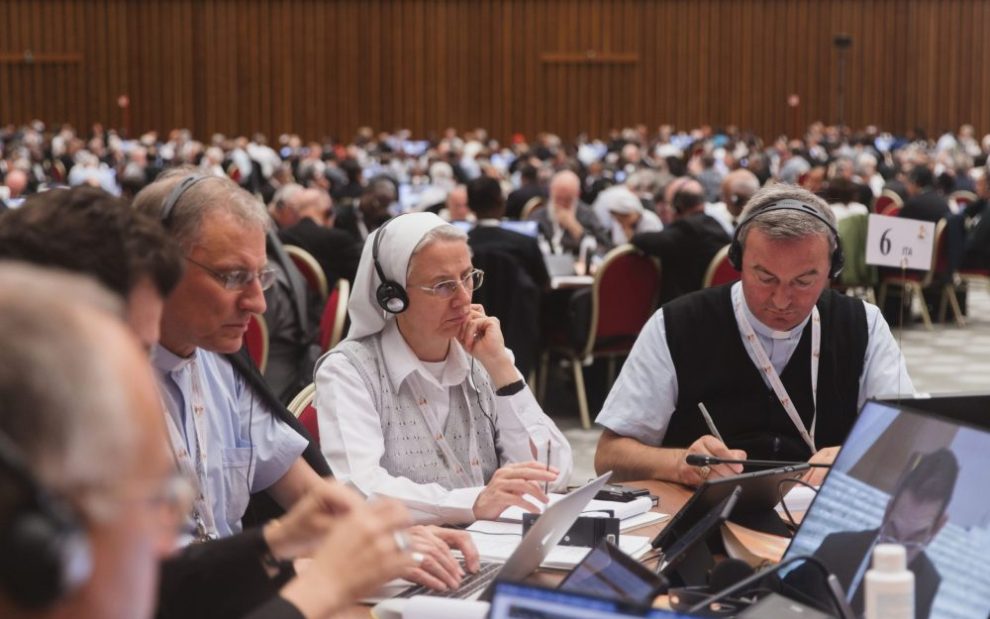As the delegates to the Synod on Synodality met in Rome for the first day of the month-long summit to determine the future of the Catholic Church, down the street several dozen women held a gathering of their own. Representing four continents and dressed in episcopal purple, the women unfurled a giant banner with a message they hoped the synod delegates would act upon: “Ordain women.”
“Don’t give up the dream,” the women sang while TV cameras rolled.
The night before, women had held a prayer vigil at a symbolic Roman church, the Basilica of St. Praxedes, whose Chapel of St. Zeno contains a ninth-century mosaic of “Theodora Episcopa,” or Bishop Theodora.
Speaking during that service on October 3, Kate McElwee, executive director of the Women’s Ordination Conference, said she experienced both hope and sadness as the synod got underway, the former “because I believe in it and want to believe in it,” and the latter because she knows that too often clericalism silences women’s voices.
A month later, after the conclusion of the 16th Ordinary General Assembly of the Synod of Bishops and the release of its synthesis document, “A Synodal Church in Mission,” McElwee is still conflicted.
While she—and the Women’s Ordination Conference in their statement—praises the synodal process and the fact that, for the first time, 54 women were able to vote alongside their male contemporaries, McElwee is frustrated that the document limits conversation about women’s ordained ministries to the diaconate—and even then postpones action and calls for further study.
The document also does not substantially acknowledge the need for greater inclusion of LGBTQ Catholics; in fact, unlike the previous synod documents, it does not even use the phrase “LGBTQ.”
“In many ways the final document felt like a side step rather than a step forward on a journey together,” McElwee says. “But perhaps realistically, that is where we as a global church are, not yet ready to move forward.”
McElwee’s response echoes that of many progressive Catholics who had hoped for more significant movement during the October 4–29 summit on issues such as expanded roles for women, inclusion and acceptance of LGBTQ Catholics, and a more pastoral response to victims of clergy sex abuse. While some, including prominent advocates for women’s inclusion in the diaconate, feel positive due to such topics being on the table, many others express frustration or mixed feelings, at best.
Yes, the greater openness of synodality is a positive change for a previously insular church, they say, but the pace of synodality is proving to be challenging.
Status quo on LGBTQ issues
Initial reports about the long-awaited synthesis document highlight the lack of significant change on women’s leadership and, especially, on LGBTQ issues. “Pope’s major Vatican summit ends without action on women deacons, mention of LGBTQ Catholics” says a headline at the National Catholic Reporter.
At 41 pages, the report makes 81 proposals and calls for further study at least 20 times. All proposed paragraphs passed with the required two-thirds vote from the 364 voting delegates. However, the paragraphs about women’s roles received the highest number of “no” votes, and one on clerical celibacy also received a high number of no votes.
Despite reports of substantial discussion of LGBTQ issues in the small groups and on the synod floor, the only document section that alludes to sexual orientation restates the status quo, saying that issues related to a host of themes—including gender identity and sexual orientation, but also the end of life, “difficult marital situations,” and artificial intelligence—are controversial because they “raise new questions.”
“In different ways, people who feel marginalized or excluded from the Church, due to their marital situation, identity and sexuality, also ask to be listened to and accompanied, and that their dignity is defended,” the report says, adding that synod participants feel “love, mercy and compassion for people who are or feel hurt or neglected by the Church.”
The lack of a more positive statement about LGBTQ Catholics in the document is “very disappointing” to Francis DeBernardo, executive director of New Ways Ministry, a Catholic outreach and advocacy organization that works for equity, inclusion, and justice for LGBTQ people. “I was not expecting that there would be a great change in doctrine or practice from this meeting, but I was hoping that there would at least be some positive movement, however small, given that in every phase of the synod up to now, Catholics around the globe let it be known that they want a more inclusive church,” he says.
More than half of the reports from the two-year process of diocesan and continental consultation mention LGBTQ people, and they are not just from Western countries, according to Jesuit Father James Martin, a synod delegate and advocate for LGBTQ Catholics.
DeBernardo, who spent the month in Rome during the synod meetings, says he heard about “robust discussions” inside the Paul VI Hall, including one delegate’s story about an LGBTQ relative who felt excluded from the church and died by suicide. That sharing reportedly moved other synod participants to tears.
Pope Francis also made headlines during the month for several high-profile meetings with LGBTQ advocates, including Martin; Loretto Sister Jeannine Gramick, the cofounder of New Ways Ministry who had previously been reprimanded by the Vatican and several U.S. bishops for her ministry; and members of the Rainbow Catholics coalition.
Marianne Duddy-Burke, executive director of DignityUSA, was part of the Rainbow Catholics group and believes the previously unthinkable meetings were the pope’s attempts to “send solidarity” to the LGBTQ community. Yet what she terms “erasure” of LGBTQ people by failing to name them in the report is “sobering.”
“The fact that in the synod assembly room there was such resistance to even using the acronym ‘LGBT’ in the report shows just how cut off too many church leaders are from the people they are supposed to be shepherding,” she says, noting that, despite the inclusion of lay and women religious, most synod delegates were still bishops.
“That signals a concerning devaluing of our lives and our place in the church and demonstrates how very important it is for LGBTQ people in Eastern Europe, in Africa, in every place where church leaders are not honoring our dignity and human rights to keep telling their stories, keep holding on to faith and hope, and keep demanding solidarity and support from the rest of the church,” she says.
Advocates acknowledge that the report suggests a need to listen to experts in scientific fields, to update Catholic anthropology, and to improve justice for church employees—all of which could be applied to LGBTQ people. Gramick, who told media that her meeting with Pope Francis was akin to “being with a friend,” says that while she is disappointed about the paucity of remarks about LGBTQ people in the document, she is neither surprised nor discouraged.
“The fact remains that our church, like society in general, is now very divided in its approach to and knowledge about LGBTQ issues,” she says. “The synod report impels me to continue to forge ahead and continue in hope.”
Hope on women deacons
Another “hot-button” issue—that of women’s leadership in general and the restoration of women to the diaconate in particular—was also reportedly the topic of many of the “Conversations in the Spirit” in the synod hall. In the previous Synod on the Amazon in 2019, delegates had discussed the possibility of ordaining women to the diaconate and married men to priesthood.
Although the current synod synthesis document falls short of putting forth a proposal on women deacons, it includes several paragraphs that summarize the discussion, both pro and con, and call for further study. It says some synod members considered ordaining women deacons “unacceptable” because they consider it a “discontinuity with Tradition.”
“For others, however, opening access for women to the diaconate would restore the practice of the Early Church. Others still, discern it as an appropriate and necessary response to the signs of the times, faithful to the Tradition, and one that would find an echo in the hearts of many who seek new energy and vitality in the Church,” the document says. The report also calls for more inclusive language and floats the idea of “new ministries” that could provide more ministerial opportunities for women.
Ellie Hidalgo, codirector of Discerning Deacons, a group that advocates for women deacons, says she is encouraged that the report recognizes women’s contributions and the need for expansion of women’s pastoral leadership. “Catholic women are the cornerstones of the church, and this document is an acknowledgment of their significant contributions to communities around the world and the need to remove obstacles that prevent women from providing increased pastoral leadership,” she says.
The synod document also calls for the release of reports from two commissions convened by Pope Francis to study the issue of women in the diaconate. Hidalgo says she is “heartened” that the synod assembly wanted to consider this research. “There is great value in the decades of theological, historical, and exegetical research that has already been published about women’s ministry as deacons in early Christianity,” she says.
But other women—especially those hoping to see more discussion of women’s ordination to the priesthood—are less enthusiastic about what some see as a “watered down” approach to women’s issues, which may have been necessary for those sections to pass.
“It is discouraging that even the consideration of restoring the women’s diaconate is still cause for concern rather than a minimum requirement at this stage and that there is no mention of priesthood at all,” says Miriam Duignan, a member of the leadership team for Women’s Ordination Worldwide who lives in Great Britain.
The Association of Roman Catholic Women Priests, which claims it has validly ordained women, called the synod’s lack of action on women deacons a “failure.” “The full equality of women in all leadership roles—in the church and society including ordained ministry—is the voice of God speaking through the people of God in our times,” says Bridget Mary Meehan, who serves as bishop in the movement.
Deborah Rose-Milavec, codirector of the church reform group FutureChurch, believes that the synodal process’s emphasis on “convergence” and unity soften a more prophetic stance on women’s issues. “The intense energy and hunger for women’s leadership, authority, and ministry in the church that was on display before and during the synod was muted because the synthesis document attempted a consensus that likely sought to placate the most conservative members in order to maintain unity within the church,” she says.
Yet Rose-Milavec is encouraged by many of the document’s proposals, including a discussion of expanding the role of lector to include preaching and attempts to include women in decision-making and ministry at all levels. “We have worked for decades to see women ordained, but we also want to see those who are not called to ordination stand as equals in every aspect of church life,” she says.
Women’s participation in the synod—and the inclusion of women as voting members—is itself progress. U.S. Cardinals Blase Cupich and Robert McElroy have said that it would be impossible to return to laypeople lacking a voice and vote at major Vatican meetings. Duignan also mentions that “for the first time, women were sitting alongside men who were obliged to listen to their opinions without interruption.”
The worldwide synodal process also meant ordinary Catholics around the world were able to raise the issues of women’s ordination to the priesthood and diaconate—topics that under two previous popes were declared “definitively” decided. “The unintended consequence of this revelation is that the campaign to ordain women priests can no longer be dismissed as a white, Western feminist attempt to usurp ‘traditional male’ roles but is a glaring injustice that concerns the future of the global church,” says Duignan.
Missteps on sexual abuse
In addition to the synthesis report, the synod delegates released another document during the final week of October: a letter to the “people of God,” meant to communicate the participants’ experience to the rest of the church. That letter highlights the priority of responding to victims of clergy sexual abuse, saying, “Above all, the Church of our time has the duty to listen, in a spirit of conversion, to those who have been victims of abuse committed by members of the ecclesial body, and to commit herself concretely and structurally to ensuring that this does not happen again.”
Yet on the same day the letter was released, it was overshadowed by reports that Father Marko Ivan Rupnik, the mosaic artist who was dismissed from the Jesuits after credible abuse accusations, had been accepted into the Diocese of Koper in his native Slovenia.
Rupnik has been accused of sexually, spiritually, and psychologically abusing two dozen adult women over decades. Dismissed by the Jesuits in June for disobedience, Rupnik remained a priest and some speculated that he received special treatment because he had been a Jesuit. Reaction to the news of his incardination was swift and negative. The Survivors Network of those Abused by Priests (SNAP) has called it “absolute madness.”
Within 48 hours, the Vatican announced that Pope Francis had lifted the statute of limitations on the allegations against Rupnik to allow for a formal investigation by the Dicastery for the Doctrine of the Faith. In the midst of this, Cardinal Robert Prevost, who heads the Vatican’s Dicastery for Bishops, was asked at a press conference how the synod was addressing sexual abuse. He responded that it was being discussed but was not the “central topic” of the assembly. “The whole life of the church does not revolve around that specific issue, as important as it is,” he said.
The synthesis report does acknowledge the church’s failure on abuse and states that minors and other vulnerable people need protections. It also notes the need to address the “structural conditions that have enabled such abuse and to make concrete gestures of penance” and recommends exploring the idea of having another judicial body, rather than a local bishop, handle abuse cases.
David Clohessy, a longtime advocate for abuse survivors, believes most survivors have “basically given up hoping the church hierarchy will ever truly reform itself.”
“Tragically, the synod made no real dent in the crux of the crisis: the church’s unhealthy monarchical structure and its deeply rooted medieval culture of clericalism,” Clohessy says. “Basically nothing in the last month has given survivors more than a tiny scintilla of hope regarding abuse and cover up.” While the document calls for justice, healing, and reconciliation, Clohessy believes preventing abuses and cover-up must come first. “That’s harder and has always deliberately been downplayed by church officials who desperately want to believe, and to convince us, that all or most of this crisis is behind us,” he says.
What’s next?
Although many of the substantive changes that some U.S. Catholics were hoping for have not yet been realized at this stage of the synod process, most people recognize that synodality is a work in progress and are hopeful that more will unfold in the months and even years ahead.
Duddy-Burke calls this October’s summit and the one scheduled for October 2024 “yeast.”
“Becoming a synodal church will require a transformation, a transfiguration into something very new. This is not the journey of two or four years,” she says. “It is something to which all of us in the church need to hold our leaders accountable.”
Advocates for women’s leadership roles, more inclusion for LGBTQ Catholics, and better prevention of sex abuse all say they are committed to continuing to work to make their issues better known as the synod process continues. “If the synod assembly did not notice the urgent cries, prayers, and hopes of women, or is unwilling to take concrete steps to dismantle church structures and policies that oppress and diminish women, then the Women’s Ordination Conference and our supporters will simply need to make ourselves even more visible,” says the WOC statement.
“Now is not the time to give up,” says DeBernardo of New Ways Ministry. “We’ve been given a great opportunity, even if at this phase the results did not turn out as we wished. We need to continue to work with the process, perhaps even harder than before, to make sure that we do not give up our place at the table.”
According to many synod participants, the success of the process itself—of deep listening, nonhierarchal community, and attempts to find convergences despite differences—is the most significant change coming out of the October meetings.
“Synodality is the way forward for the church,” Rose-Milavec says. “And, as a continuation of the Second Vatican Council, it holds the promise of renewing the structures and practices of the church to better serve the demands of the gospel for our time.”
As Pope Francis said in his homily at the synod’s closing Mass: “Today we do not see the full fruit of this process, but with farsightedness we look to the horizon opening up before us.”
For more on the synod on synodality:
- For the synod to succeed, the church must listen to all of us
- Can you hear us? A look at the ongoing synod
- Want to understand the Synod? Look to the catacombs.
This article also appears in the January 2024 issue of U.S. Catholic (Vol. 89, No. 1, pages 30-35). Click here to subscribe to the magazine.
Image: Synod.va/Langarica














Add comment